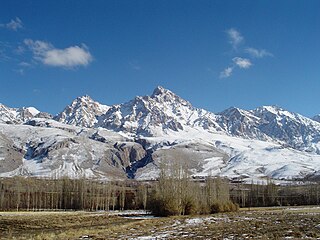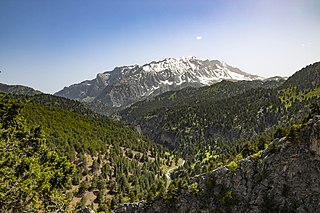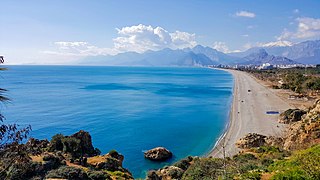



| Name | Altitude | Mountain Range | Coordinates |
|---|---|---|---|
| Büyük Ağrı (Mount Ararat) | 5,137 m (16,854 ft) | Ağrı | 39°42′09″N44°18′00″E / 39.70250°N 44.30000°E |
| Gelyansın or Uludoruk (Reşko Tepesi) | 4,134 m (13,563 ft) | Taurus | 37°29′09″N44°00′18″E / 37.48583°N 44.00500°E |
| Cilo Dağı | 4,116 m [1] (13,504 ft) | Taurus | |
| Süphan | 4,058 m (13,314 ft) | 38°55′54″N42°50′03″E / 38.93167°N 42.83417°E | |
| Kaçkar Dağı highest peak in Kaçkarlar | 3,932 m (12,900 ft) | Kaçkarlar | 40°50′12″N41°09′48″E / 40.83667°N 41.16333°E |
| Erciyes (Mount Erciyes) | 3,916 m (12,848 ft) | Central Anatolia Region | 38°32′06″N35°27′03″E / 38.53500°N 35.45083°E |
| Küçük Ağrı (Lesser Ararat, Little Ararat, Mount Sis) | 3,896 m (12,782 ft) | Ağrı | 39°39′N44°24′E / 39.650°N 44.400°E |
| Handeyade (Catalkaya, Samdi) | 3,794 m (12,448 ft) | Cilo-Sat | 37°19′N44°15′E / 37.31°N 44.25°E |
| Kızılkaya Highest Peak in Anti-Taurus Mountains (Aladağlar) | 3,767 m (12,359 ft) | Aladağlar | |
| Büyük Demirkazık (Greater Demirkazık) | 3,756 m (12,323 ft) | Aladağlar | 37°47′51″N35°09′33″E / 37.79750°N 35.15917°E |
| Kısara | 3,752 m (12,310 ft) | Cilo-Sat | |
| Mazanı | 3,725 m (12,221 ft) | Cilo-Sat | |
| Emler | 3,723 m (12,215 ft) | Aladağlar | 37°48′23″N35°08′55″E / 37.8065°N 35.1486°E |
| Verçenik | 3,711 m (12,175 ft) | Kaçkarlar | |
| Kaldı | 3,688 m (12,100 ft) | Aladağlar | |
| Başet Tepesi [2] (Gürpınar, Van) | 3,684 m (12,087 ft) | İhtiyar Şahap Mountains | |
| Şilan Mountains | 3,670 m (12,040 ft) | Cilo-Sat | |
| Kızılyar | 3,654 m (11,988 ft) | Aladağlar | |
| Gürtepe | 3,630 m (11,910 ft) | Aladağlar | |
| Sematepe | 3,623 m (11,886 ft) | Aladağlar | |
| Çağalın Başı | 3,612 m (11,850 ft) | Aladağlar | |
| Mount Tendürek | 3,584 m (11,759 ft) | ||
| Torasan | 3,584 m (11,759 ft) | Aladağlar | |
| Alaca (Lorut) | 3,582 m (11,752 ft) | Aladağlar | |
| Vayvay | 3,563 m (11,690 ft) | Aladağlar | |
| Bulut | 3,562 m (11,686 ft) | Kaçkarlar | |
| Eznevit | 3,560 m (11,680 ft) | Aladağlar | |
| Karasay | 3,550 m (11,650 ft) | Aladağlar | |
| Mount Artos | 3,550 m (11,650 ft) | İhtiyar Şahap Mountains | |
| Boruklu | 3,548 m (11,640 ft) | Aladağlar | |
| Gevaruk | 3,540 m (11,610 ft) | Cilo-Sat | |
| Çandır Dağı | 3,537 m (11,604 ft) | ||
| Güngörmez | 3,536 m (11,601 ft) | Kaçkarlar | |
| Sulağankaya | 3,530 m (11,580 ft) | Aladağlar | |
| Soğanlı Dağ | 3,527 m (11,572 ft) | Kaçkarlar | |
| Medetsiz Highest peak in Bolkar Mountains | 3,524 m (11,562 ft) | Bolkar Mountains | |
| unnamed near Çağalın Başı | 3,517 m (11,539 ft) | Aladağlar | |
| Direktaş | 3,510 m (11,520 ft) | Aladağlar | |
| Orta Dağ | 3,500 m (11,500 ft) | Aladağlar | |
| Karataş | 3,495 m (11,467 ft) | Kaçkarlar | |
| Keşif | 3,475 m (11,401 ft) | Bolkar Mountains | |
| Cebelbaşı | 3,474 m (11,398 ft) | Aladağlar | |
| Liblin Tepe | 3,472 m (11,391 ft) | Kaçkarlar | |
| Karasay | 3,472 m (11,391 ft) | Aladağlar | |
| Güzeller | 3,461 m (11,355 ft) | Aladağlar | |
| Kösedağ Dağı | 3,433 m (11,263 ft) | 39°53′43″N42°38′37″E / 39.89528°N 42.64361°E | |
| Sıyırmalık | 3,426 m (11,240 ft) | Aladağlar | |
| Tearzin | 3,415 m (11,204 ft) | Cilo-Sat | |
| Küçük Demirkazık | 3,400 m (11,200 ft) | Aladağlar | |
| Tahtakaya | 3,372 m (11,063 ft) | Bolkar Mountains | |
| Didvake | 3,350 m (10,990 ft) | Kaçkarlar | |
| Büyük Dağ Tepe | 3,328 m (10,919 ft) | Kaçkarlar | |
| Sat Başı | 3,302 m (10,833 ft) | Cilo-Sat | |
| Altıparmak | 3,301 m (10,830 ft) | Kaçkarlar | |
| Marsis | 3,300 m (10,800 ft) | Kaçkarlar | |
| Kardal | 3,300 m (10,800 ft) | Cilo-Sat | |
| Hasan Dağı | 3,253 m (10,673 ft) | 38°08′N34°11′E / 38.133°N 34.183°E | |
| Mescit Mountains | 3,239 m (10,627 ft) | ||
| Bingöl Mountains | 3,193 m (10,476 ft) | 39°21′35″N41°22′56″E / 39.35972°N 41.38222°E Contents | |
| Büyük Ejder | 3,176 m (10,420 ft) | ||
| Erek Dağı | 3,175 m (10,417 ft) | 38°28′N43°30′E / 38.467°N 43.500°E | |
| Kargapazarı Mountains | 3,169 m (10,397 ft) | ||
| Nurhak Dağı | 3,081 m (10,108 ft) | ||
| Kızlar Sivrisi | 3,069 m (10,069 ft) | Beydağları | |
| Çakmak Mountain | 3,063 m (10,049 ft) | ||
| Nemrut | 3,050 m (10,010 ft) | 39°25′N41°31′E / 39.41°N 41.51°E | |
| Akdoğan | 2,879 m (9,446 ft) | Akdoğan Mountains | 39°11′05″N41°51′42″E / 39.18472°N 41.86167°E |
| Kösedağ Dağı | 2,794 m (9,167 ft) | 40°04′38″N37°58′18″E / 40.07722°N 37.97167°E | |
| Şerafettin | 2,675 m (8,776 ft) | ||
| Göztepe | 2,594 m (8,510 ft) | Akdoğan Mountains | 39°06′46″N41°50′47″E / 39.11278°N 41.84639°E |
| Mount Honaz | 2,571 m (8,435 ft) | ||
| Uludağ | 2,543 m (8,343 ft) | 40°04′10″N29°13′17″E / 40.06944°N 29.22139°E | |
| Cemalverdi Mountains | 2,438 m (7,999 ft) | 39°18′09″N42°37′32″E / 39.30250°N 42.62556°E | |
| Tahtalı | 2,366 m (7,762 ft) | Beydağları | 36°32′13″N30°26′31″E / 36.53694°N 30.44194°E |
| Ahır | 2,344 m (7,690 ft) | Southeastern Taurus Mountains | 37°39′N37°02′E / 37.65°N 37.03°E |
| Murat Mountain | 2,312 m (7,585 ft) | ||
| Karadağ | 2,271 m (7,451 ft) | 37°15′N33°05′E / 37.25°N 33.08°E | |
| Girekol | 2,145 m (7,037 ft) | 39°06′14″N43°25′34″E / 39.104°N 43.426°E | |
| Şaphane mountain | 2,120 m (6,960 ft) | ||
| Kazdağı (Mount Ida) | 1,770 m | 39°42′N26°50′E / 39.700°N 26.833°E | |
| Spil Dağı | 1,517 m (4,977 ft) | ||
| Madra Mountains | 1,230 m | Aegean Region | |
| Mahya Dağı | 1,031 m (3,383 ft) | Yıldız Mountains | 41°47′N27°37′E / 41.783°N 27.617°E |

The Anatolian side of Turkey is the largest portion in the country that bridges southeastern Europe and west Asia. East Thrace, the European portion of Turkey comprises 3% of the country and 10% of its population. East Thrace is separated from Asia Minor, the Asian portion of Turkey, by the Bosporus, the Sea of Marmara and the Dardanelles. İskilip, Çorum province, is considered to be the geographical center of Earth. Turkey is very vulnerable to earthquakes.

The Taurus Mountains are a mountain complex in southern Turkey, separating the Mediterranean coastal region from the central Anatolian Plateau. The system extends along a curve from Lake Eğirdir in the west to the upper reaches of the Euphrates and Tigris rivers in the east. It is a part of the Alpide belt in Eurasia.

The Anti-Taurus Mountains or Aladaglar are a mountain range in southern and eastern Turkey, curving northeast from the Taurus Mountains.

The Armenian highlands is the most central and the highest of the three plateaus that together form the northern sector of West Asia. Clockwise starting from the west, the Armenian highlands are bounded by the Anatolian plateau, the Caucasus, the Kura-Aras lowlands, the Iranian Plateau, and Mesopotamia. The highlands are divided into western and eastern regions, defined by the Ararat Valley where Mount Ararat is located. Western Armenia is nowadays referred to as eastern Anatolia, and Eastern Armenia as the Lesser Caucasus or Caucasus Minor, and historically as the Anti-Caucasus, meaning "opposite the Caucasus".

Mount Hasan is a volcano in Anatolia, Turkey. It has two summits, the 3,069 metres (10,069 ft) high eastern Small Hasan Dagi and the 3,253 metres (10,673 ft) high Big Hasan Dagi, and rises about 1 kilometre (0.62 mi) above the surrounding terrain. It consists of various volcanic deposits, including several calderas, and its activity has been related to the presence of several faults in the area and to regional tectonics.

Nemrut is a dormant volcano in Tatvan district, Bitlis province, Eastern Turkey, close to Lake Van. The volcano is named after King Nimrod who is said to have ruled this area in about 2100 BC.


Mount Kaçkar, with an elevation of 3,937 meters, is the highest peak in the Kaçkar Mountains. The mountain may be climbed by the northeast ridge route beginning from the village Yukarı Kavrun.

The Pontic Mountains or Pontic Alps form a mountain range in northern Anatolia, Turkey. They are also known as the Parhar Mountains in the local Turkish and Pontic Greek languages. The term Parhar originates from a Hittite word meaning "high" or "summit". In ancient Greek, the mountains were called the Paryadres or Parihedri Mountains.

The Black Sea Region is a geographical region of Turkey. The largest city in the region is Samsun. Other big cities are Zonguldak, Trabzon, Ordu, Tokat, Giresun, Rize, Amasya and Sinop.

The Eastern Anatolia Region is a geographical region of Turkey. The most populous province in the region is Van Province. Other populous provinces are Malatya, Erzurum and Elazığ.

The Mediterranean Region is a geographical region of Turkey. The largest city in the region is Antalya. Other big cities are Adana, Mersin and Kahramanmaraş.

The geology of Turkey is the product of a wide variety of tectonic processes that have shaped Anatolia over millions of years, a process which continues today as evidenced by frequent earthquakes and occasional volcanic eruptions.

As of 2000 about 9300 species of vascular plant were known to grow in Turkey. By comparison, Europe as a whole contains only about 24% more species, despite having thirteen times the area.

Aintab plateau or Gaziantep plateau is a low, gently undulating plateau that forms the westernmost part of the Southeastern Anatolia Region in Turkey. It forms the northwestern end of the Arabian Plate where it meets the Anatolian Plate at the East Anatolian Fault. The plateau lies in the Turkish provinces of Gaziantep, Kilis, and Adıyaman. In Classical Antiquity, this was the region of Commagene. Gaziantep (Aintab) is located nearly in the south-center of the plateau.

The Eastern Anatolian montane steppe is a temperate grasslands, savannas, and shrublands ecoregion. It is located in the Armenian Highlands, covering parts of eastern Turkey, Armenia, Azerbaijan, southern Georgia, and northwestern Iran.

The Tahtalı Mountain Range (Turkish)) Tahtalı Dağları are located in the Central Anatolian area of Turkey. It lies in the middle of the Taurus Mountains, mostly between the provinces of Kayseri, Adana, with smaller areas within the provinces of Sivas and Kahramanmaraş.

Mount Erciyes, also known as Argaeus, its etymon, is an inactive volcano in Kayseri Province, Turkey. It is a large stratovolcano surrounded by many monogenetic vents and lava domes, and one maar. The bulk of the volcano is formed by lava flows of andesitic and dacitic composition. At some time in the past, part of the summit collapsed towards the east.

The Anatolian Biogeographic Region is a biogeographic region of Turkey, as defined by the European Environment Agency.
{{cite journal}}: Cite journal requires |journal= (help)